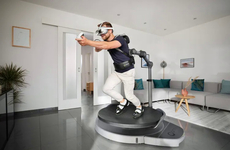
OptiTrack's Active VR System Lets Player Movements Control the Game
Justin Lam — March 27, 2018 — Tech
OptiTrack's Active VR system is making the VR experience more immersive by integrating actual user movement. One of the issues currently facing VR gaming is the disconnect between movement controls. Using a controller for locomotion -- whether it be a teleportation style mechanism or use of a thumbstick -- leads to a general disconnect in immersion and actively reminds the user that they are just wearing a screen on their face. But OptiTrack is hoping to change this with its Active VR system that will allow players to move around in the game the same way they do in real life. The entire system is wireless and utilizes cameras to actively track movement.
OptiTrack recently showcased its new system at GDC 2018 using Arizona Sunshine from Vertigo Games as a demo. The showcase featured a host of VR accessories, including the Oculus VR HMD, the Hardlight VR haptic feedback vest and a Stryker VR rifle-style controller. The system worked surprisingly well with low latency and can even support four-players.
OptiTrack recently showcased its new system at GDC 2018 using Arizona Sunshine from Vertigo Games as a demo. The showcase featured a host of VR accessories, including the Oculus VR HMD, the Hardlight VR haptic feedback vest and a Stryker VR rifle-style controller. The system worked surprisingly well with low latency and can even support four-players.
Trend Themes
1. Active VR Systems - Incorporating real user movement to improve immersion and decrease the disconnect currently experienced with controller-based movement in VR gaming.
2. Wireless VR Tracking - Utilizing cameras and wireless technology to create an untethered VR experience, enhancing user freedom and ease of movement.
3. Multi-player VR - Designing systems that allow for multiple users to experience VR together, opening up opportunities for social experiences and collaborative gaming.
Industry Implications
1. Gaming Industry - Incorporating Active VR systems can create a more immersive gaming experience, allowing for the creation of new game play mechanics and resulting in increased player engagement.
2. Virtual Reality Industry - Developing wireless VR tracking systems can further improve upon the already immersive experience of VR, allowing for greater freedom of movement and accessibility.
3. Entertainment Industry - Incorporating multi-player VR systems can create new opportunities for social experiences in entertainment settings such as theme parks and immersive events.
2.2
Score
Popularity
Activity
Freshness























